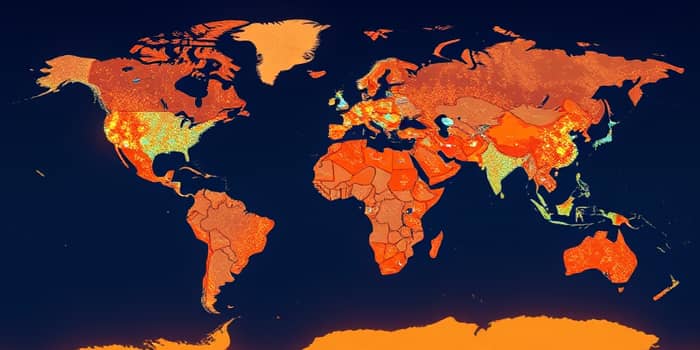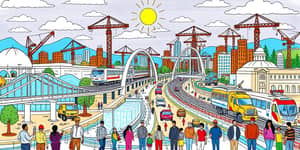
The global economy has shown signs of revival in recent years, with headline growth numbers hinting at a gradual return to stability. After a sharp contraction during the pandemic, international organizations forecast a global expansion of 2.8% in 2025, only modestly up to 2.9% in 2026. Yet this overall picture masks a striking reality: economic gains are unevenly distributed across and within countries, leaving many communities further behind.
Far from converging, the recovery paths of different regions are diverging. While major urban centers and export-driven economies attract investment and skilled labor, rural areas and former industrial regions struggle with stagnating job markets and decaying public services. As a result, deepening subnational and regional disparities have become one of the defining challenges of the post-recovery era.
Global growth projections for 2025 and 2026 reveal clear splits between leading and lagging economies. The United States, after expanding by 2.8% in 2024, is expected to slow to 1.9% in 2025. China, hindered by weak consumption and demographic pressures, is likely to hover just under 5% growth. In Europe and Japan, recovery remains sluggish following underwhelming 2024 performance. Meanwhile, major African economies such as Egypt, Nigeria, and South Africa have driven a gentle uptick in the region, and Latin American and Western Asian nations benefit from easing monetary policies and stronger exports.
This data underscores a crucial point: headline growth rates offer only a partial view. Behind each number lie stories of thriving metropolitan hubs and struggling hinterlands.
Within high-income nations, the phenomenon of 'left-behind' regions has become entrenched. In the United States, certain city-regions face chronic unemployment, wage stagnation, and rising 'deaths of despair' among lower-skilled populations. In the United Kingdom, income gaps between London and the South East versus northern and rural regions remain stark, exacerbated by left-behind communities facing entrenched unemployment and prohibitively high housing costs that limit work mobility.
Across Latin America, a 2.5% growth rate in 2024 conceals extremes: Chile’s dynamic urban centers enjoy robust expansion, while Argentina struggles with inflation above 100% and currency volatility that undermine local living standards. Sub-Saharan Africa’s median debt-to-GDP ratio below 60% masks significant variation; some nations face debt crises, limiting fiscal space for development programs. Despite headline improvements, many rural districts and small towns see little benefit from macroeconomic gains.
The widening gulf between prosperous and struggling areas stems from both long-term structural shifts and sudden crises. On one hand, deindustrialization and the shift toward knowledge-intensive industries have left former manufacturing heartlands and rural communities at a disadvantage. Agglomeration effects concentrate skilled labor and capital in leading cities, reinforcing success and sidelining peripheral zones. Moreover, barriers to capital and labor mobility—from high housing costs to place attachment—hinder the ability of workers to seek opportunities elsewhere.
On the other hand, recent shocks have amplified these divides. The COVID-19 pandemic triggered asymmetric impacts: well-resourced urban centers adapted through remote work and digital services, while regions reliant on tourism, small manufacturing, or in-person services bore the brunt. Trade tensions and weak global demand have further penalized export-dependent and resource-rich regions.
The human and economic costs of persistent disparities are profound. Areas with persistent high unemployment and low growth experience declining well-being, mounting mental health crises, and shorter life expectancy. Local governments facing fiscal constraints cut back on essential services, leading to long-term public service erosion—from education and healthcare to transport infrastructure.
Moreover, growing inequality fuels social unrest and political polarization. Populist movements gain traction by exploiting discontent in marginalized regions, threatening national cohesion.
Efforts to address regional imbalances have ranged from ad hoc redistribution to targeted public investments. Yet many traditional approaches have fallen short of reversing entrenched trends. Renewed debates focus on whether convergence is achievable or if divergence has become self-reinforcing. Scholars and policymakers weigh options between direct transfers, structural interventions, and market-led mobility enhancements.
International bodies emphasize the need for resilience-building and adaptive policy frameworks that can withstand future shocks. In the United States and United Kingdom, proposals include bold housing reforms, mass transit expansion, and place-based skills training. The IMF advocates for conditional fiscal transfers tied to outcomes while the UN calls for stronger social safety nets and community-led development.
Beyond infrastructure and fiscal transfers, digital inclusion is critical. Expanding broadband internet to underserved communities can spur entrepreneurship and remote work, providing new pathways out of persistent regional deprivation.
The story of the post-pandemic recovery is not merely one of GDP figures but of communities left behind and the promise of shared prosperity unfulfilled. As policymakers craft the next generation of economic strategies, they must grapple with the reality that inter-regional inequality threatens social cohesion. Only by combining structural investments, redistributive measures, and policies that facilitate mobility can nations aspire to truly inclusive growth.
Addressing regional disparities is both an economic imperative and a moral obligation. The time for incremental fixes has passed; bold, comprehensive action is needed to bridge the divide and ensure that no community is left behind.
References













